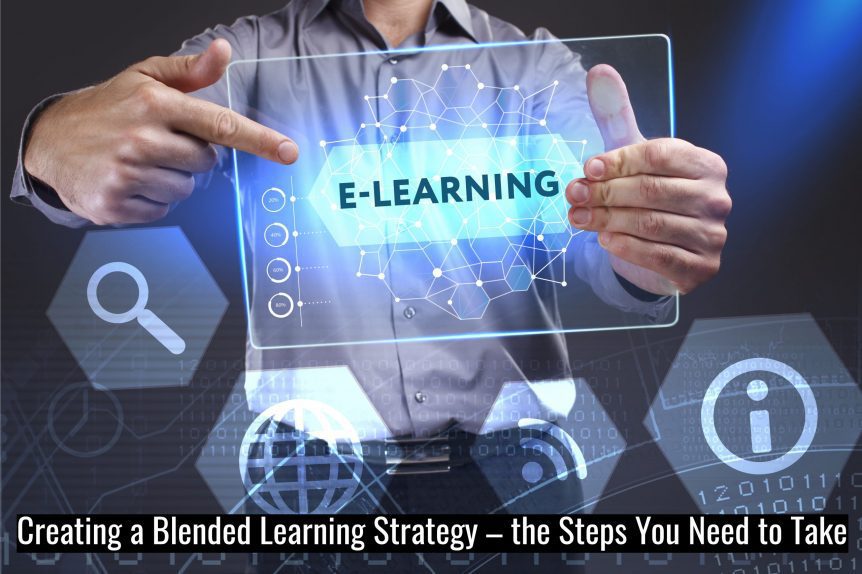Creating a Blended Learning Strategy – the Steps You Need to Take
Have you heard of blended learning and want to know if it will work in your business? Do you want to know how to go about implementing blending learning?
A blended learning strategy involves both instructor-led training and e-learning. It’s an approach the delivers the best of both worlds, i.e. you get the benefits of e-learning as well as the benefits of instructor-led training. The result is a better learning experience and improved knowledge retention.
Of course, blended learning is not suitable for every situation, but where it is suitable, the results can be impressive. Here are the key steps you need to take to create a blended learning strategy.
Step 1 – Decide on the Objectives of the Strategy
The first thing you should do is decide on the business outcomes and/or behavioural changes you want to achieve with the blended learning strategy.
Let’s use an example of onboarding, an area of training in your business that might be suited to a blended classroom and e-learning approach. The objectives in this example of onboarding could be:
- Improve retention rates
- Increase employee satisfaction in the onboarding process
- Improve the productivity of new recruits in the first six months of their employment
- Reduce the time it takes for new employees to become self-sufficient
Deciding on your objectives for the blended learning strategy is an essential part of the process and helps you decide on the content you will need, how each element will be delivered, and the overall structure.
It’s also important you decide at this stage how you will measure success.
Step 2. Select an E-Learning Developer
The most effective way of delivering a blended learning strategy is to work closely with an experienced e-learning developer in the UAE.
Your e-learning developer will do all the heavy lifting in regard to the e-learning elements, plus they will be able to help you with other aspects of the strategy, including ensuring the various elements of the training blend efficiently and effectively.
Step 3. Decide on the Delivery Methods of Each Element
The first part of the next step involves deciding on the elements your strategy will have and then deciding on the delivery method for each element. The main delivery method options include:
- Instructor-led classroom-based training
- Instructor-led online training, such as a webinar or video conferencing sessions
- E-learning elements
When making these decisions, base your choices on the best way to deliver the information to learners while also taking into account the overall structure of the course.
Other things you should consider include levels of interactivity and engagement, geographical location, budget, and scalability.
Step 4. Build the Structure
You now need to add detail to the structure. Part of this includes the order of each course element. You may also have elements that don’t need to be completed in order – these need to be factored in too.
It’s also important to plan out how the various elements will flow and link together. This particularly applies as learners transition from instructor-led elements to e-learning elements and back again.
Importantly, remember the structure of your blended learning strategy can take many forms. For example, an initial e-learning module could lead to a quiz that assesses the learner’s competency level to determine other elements they need to complete as well as those they may be able to skip.
Another example is an in-classroom element set up as a group collaboration activity that takes place after learners have successfully completed an e-learning module.
Step 5. Add Digital Resources
It often helps to create additional digital resources that will complement the instructor-led elements of the training. This could be summaries of the information given in the instructor-led training or additional reading materials and resources. It could also be an e-learning module designed to reinforce the information and assess the learners’ knowledge.
Step 6. Create the Content
In relation to the e-learning elements, you will need to provide your e-learning developer with the content they need to include in the course.
You will also need to create content for the instructor-led elements of the training, including any resource materials.
Step 7. Communicate with Learners
It’s important you explain to learners the approach you are taking in regard to their training, particularly in relation to the different types of element and the delivery methods that will be used. After all, you don’t want learners to be confused about how everything connects together.
Step 8. Get Feedback
By this stage, learners should be progressing through the various elements of your blended learning strategy. You should use this time to get a better understanding of their experience and whether or not they are happy.
This is normal practice for all types of training, particularly e-learning. In this case, however, you should also find out learners’ views on blended learning and how they have found the overall experience.
Step 9. Assess Outcomes
One of the things you should have done at the start of this process was to decide how you would measure the success of your blended learning strategy. It’s time now to conduct that assessment. You should do this with a focus on making improvements both with this training strategy and those you develop in the future.
A Systematic Approach
Finally, while blended learning offers significant benefits, it is a more complicated approach than delivering all the training via e-learning. Careful planning is essential, therefore, plus it is crucial you work with an e-learning developer with knowledge of blended learning.
